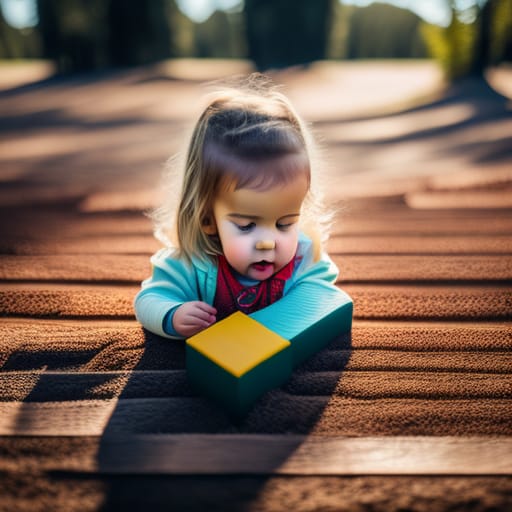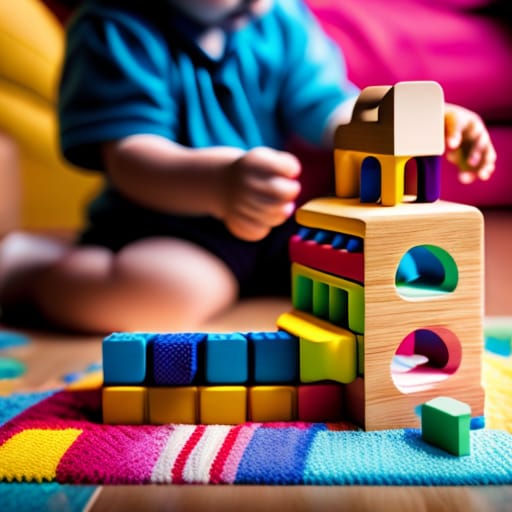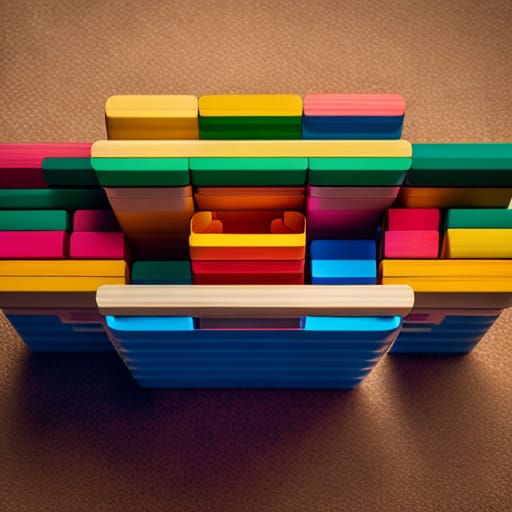Bright colors, funky shapes, towers rising high—building blocks entertain toddlers while helping their minds grow. These classic toys stimulate a child’s imagination and teach skills needed for the preschool years ahead.
Whether your tot is just starting to grip objects or can already construct an elaborate castle, block play encourages healthy development. From improved motor skills to better cognition, the benefits stack up!
This beginner’s guide has the blocks on everything you need to know about the best stacking toys for your little one. We’ll cover how blocks impact development, features that make blocks safe and fun, and top products that foster creativity.

Why Toddlers Need Blocks
Blocks do so much more than just provide amusement. As one of the most versatile toddler toys, they aid physical, mental, social, and emotional growth.
Develop Fine Motor Skills
Grasping, holding, rotating, stacking—the motions toddlers use playing with blocks help strengthen their small hand muscles. These are key skills needed for later activities like writing and dressing themselves.
Improve Hand-Eye Coordination
Fixating on a block, reaching accurately, adjusting grasp—blocks hone eye-tracking abilities and hand-eye sync. Strong coordination assists with sports, pouring liquids, and more.
Build Cognitive Capacity
Sorting by shape, size, color; visualizing designs; balancing asymmetric structures—block play exercises cognitive faculties. Enhanced concentration, planning, and problem-solving benefit learning.
Gain Math and Reading Readiness
ABC blocks, counting blocks, and shape blocks acquaint toddlers with letters, numbers, colors, and geometric forms—key math and reading preparatory skills.
Improve Social and Emotional Growth
Collaborative building, sharing materials, imaginative storytelling—blocks enable interactive play that builds relationship abilities. Toddlers also gain confidence mastering construction challenges.
In essence, blocks establish an ideal environment for developing young minds and bodies in an engaging way.
Choosing Safe Blocks for Toddlers
While the benefits clearly stack up, not all blocks are created equal when it comes to safety. Focus on these features to find blocks suited for tiny builders:
+ Size – Avoid very small blocks that pose a choking hazard for kids under 3 years. Chunkier blocks are best!
+ Shape – Look for smooth, rounded edges without sharp corners or points.
+ Weight – Lightweight blocks allow for easier lifting and construction.
+ Materials – Seek solid wood, durable plastics, cloth, or soft foam.
+ Paint & Finish – Ensure paints and finishes are non-toxic to prevent kids putting them in their mouths.
+ No Detachable Pieces – Remove risks of loose magnets, googly eyes falling off, etc.
+ Sturdy Construction – Blocks should not easily break, crack or fall apart after repeated use.
Close parental supervision is still a must for toddlers, especially with structures over 6 blocks high that may accidentally topple. But choosing blocks designed specifically to be toddler-safe gives more freedom for self-expression while minimizing frustrations.
Best Blocks for Open-Ended Play
The best blocks allow for open-ended play driven by a toddler’s innate creativity rather than rigid step-by-step instructions. These blocks have infinite combinations for building just about anything they can imagine!
Classic Wooden Unit Blocks
These uniform wooden blocks engraved with letters or numbers are a childhood staple. Their simple, unfinished wood design and standard cuboid and prism shapes encourage inventing all kinds of structures.
Helpful for developing early math concepts, cognition, and motor skills too. Look for sets with 30-100+ pieces.
Colorful Wooden Stackers
Add color and variety with stacking blocks of solid wood cut into different whimsical forms like animals, fruits, or geometric shapes. These inject more creativity into construction play.
Great for practicing hand-eye coordination while learning colors and block properties. Ideal starter sets for younger toddlers.
Interlocking Building Blocks
These colorful plastic blocks connect through protrusions and channels encouraging experimentation with early engineering concepts. Build upwards with pillars or outwardsacross a flat surface.
Allow school-aged kids to construct more elaborately too. Help develop spatial reasoning, counting, grouping, and design skills.
Foam ABC/Number Blocks
Soft, squishy foam blocks have alphabet letters or numbers printed on the sides. Toddlers learn to recognize letters and numerals while spelling names or counting objects in their structures.
Supports literacy and math readiness. Textured grip-friendly surfaces help little hands practice grasping. Washable too!
Cardboard Blocks
These affordable and recyclable blocks allow kids to construct imaginative structures that can then be colored or painted without worry of staining. Sturdier than regular cardboard.
Great open-ended building material to unleash toddlers’ creativity both indoors and out. Promote early artistry, design skills and responsibility through clean-up.
Top Pick: Maple Landmark NameTrain Cube Set
These 75+ sustainably-harvested maple wood blocks bring classic ABC/number recognition play up a level with engraved train cars for spelling names. Compatible with other wooden blocks for creative open-ended fun.
Durable, smooth sanded finish is safe even for mouths. Made in the USA too!
Key Benefits of Block Play by Age
Toddlers develop rapidly in the first 3-4 years across physical, mental, social and emotional domains. Check major milestones blocks can help achieve at different ages:
12-18 Months:
- Develops pincer grasp
- Learns cause-and-effect
- Experiments with object stacking
18-24 Months:
- Refines hand-eye coordination
- Starts symbolic pretend play
- Groups by color and shape
2-3 Years:
- Builds tower of 4+ blocks
- Recognizes some letters
- Enjoys collaborative building
3-4 Years:
- Constructs bridge-like structures
- Correctly names basic shapes
- Creates thematic scenes with blocks
Pay attention to which developmental stages your toddler is working through and provide block set features to nurture new abilities!

Setting Up a Block Play Area
Designating a permanent spot for building blocks allows toddlers to leave creations intact for continuing later. This teaches planning skills too.
Location: Choose an open corner space in living room, playroom, or bedroom. Nearadult supervision is best.
Flooring: Low-pile rugs provide a soft but solid surface for balancing block structures. Carpet may topple stacks.
Storage: Use labeled bins, baskets or shelving sized for different block sets to organize. Low open storage encourages self-clean-up.
Seating: Add pillows, cushions or a small play table and chairs for comfortable building. Protective floor mats assist with long build sessions.
Safety: Ensure all furniture has secured tip-straps, TVs/devices are safely out of reach, and choking hazards are contained. Check area regularly for risks.
Building block play spaces tailored to toddlers enable learning through safe, independent and imaginative hands-on play.
Fun Ways to Use Blocks as Toddler Gets Older
Adapt block activities to your toddler’s evolving abilities for an engaging toy that truly grows with them!
For Babies
Explore senses by mouthing, shaking, banging different textured blocks with supervision. Encourage grasping towers to knockover.
For 1-Year-Olds
Guide basic stacking/nesting of 2-3 blocks. Name colors/shapes while toddler holds blocks. Create fun noises, songs about block properties while they listen.
For 2-Year-Olds
Have them organize blocks by color, size, shape into sorting boxes. Build roadlike structures by connecting squares. Act out a three-block story.
For 3-4 Year Olds
Play “I Spy” games finding letter/number blocks. Task them with building something scene-specific like a barn. Combine with other toys like trains or animals. See who can stack the tallest!
For the Whole Family
Older kids can create elaborate block structures for toddler siblings to gently knock down. Or build together, combining imaginations. Act out favorite storybooks using blocks as props too.
Don’t limit blocks to just your toddler’s play. Finding new ways the whole family can engage with blocks multiplies learning opportunities.
Top 5 Benefits of Wooden Blocks
Wood block sets remain popular for good reason—they deliver distinct developmental upsides.
Promote Sustainability – Ethically-sourced wooden toys like maple blocks made from forest thinnings teach eco-awareness.
Limit Plastic Waste – Wooden blocks avoid more single-use plastics polluting oceans and landfills.
Durable & Timeless – Hardwood blocks withstand years of heavy use, becoming heirloom toys.
Encourage Imagination – Natural unfinished wood sparks more open-ended creativity without pre-defined themes.
Safe Material – Unpainted wood has no toxins, smooth edges better for teething toddlers.
Choosing eco-friendly solid wood blocks made to last demonstrated to kids the importance of quality over quantity in toys, saving parents money over time.
Top 5 Block Tips for Parents
Make block play more fruitful and frustration-free with these handy tips:
Add Variety – Rotate different block sets to keep construction exciting across motor skills.
Try Templates – Provide outlines, molds or photos as idea starters to spark imagination.
Build Together – Join creating starter tower bases. Ask questions about their structure ideas.
Display Creations – Exhibit favorite buildings on shelves before storing to encourage pride, taking pictures to document.
Assign Clean-Up – Make putting blocks back into assigned storage spots a habit from the start. Play fun clean-up music!
Taking an active role in block activities without taking over stretches critical thinking. And establishing tidy habits preserves nice play spaces.

Ready to Start Stacking?
The many developmental benefits of block play make buying blocks well worth the investment into your toddler’s future success. With so many varieties to choose from, focus first on finding chunky blocks sized right for small hands with rounded corners and safe materials.
Open-ended blocks encourage the most imaginative hands-on play across flexible themes. Yet also consider letter, number or plastic interlocking blocks providing additional learning opportunities. Whichever types you select, look for brands adhering to domestic safety standards, like Maple Landmark, which manufactures its blocks sustainably right here in the USA.
Be sure to carve out a designated block area in your home to keep the building going strong. Then dive into our suggested activities adapted for different toddler ages. Soon you’ll have clever little architects constructing magnificent towers!
Let the constructive fun begin!
Frequently Asked Questions
What are the best first blocks for my 1-year-old? For 1-year-olds just starting, choose large, lightweight wooden blocks or soft foam alphabet/number blocks that are easy to grip and stack. Avoid small pieces that could pose safety risks.
What skills do stacking toys develop? Excellent stacking toys like blocks improve fine motor control, hand-eye coordination, cognition, early math concepts like sorting/counting, literacy preparation, spatial skills, and social/emotional development through interactive play.
How can I make block play safer for my toddler? Look for chunky blocks with smooth, rounded corners made of non-toxic materials. Provide supervision, especially for towers over 6 blocks high. Designate a safe, open floor space for building by securing nearby furniture and storing choking hazards out of reach.
What is the best way to organize all my toddler’s blocks?
Use labeled bins, baskets, or shelving sized for each different block set to neatly organize. Low open storage near play area helps toddlers learn clean-up habits while encouraging independent building.
How do I keep my toddler engaged with blocks over time? Introduce new block sets with different colors, themes, or building properties like interlocking pieces. Provide story starters, templates, or build challenges. Assign collaborative projects for siblings. Rotate toys to maintain novelty.